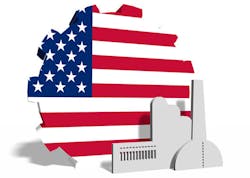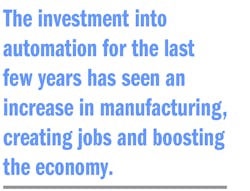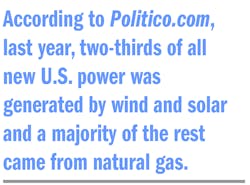Trump’s Policies on Science and Engineering: Hurtful or Helpful?
The science and engineering policies of President-elect Donald Trump are still in the developing stages. During the campaign, very few discussions centered on the future of science and engineering. The most talked-about topics were manufacturing at home and overseas, NASA’s efforts into deep space exploration, and the investment into the nation’s crumbling infrastructure. A report from the Information Technology and Innovation Foundation (ITIF) compiled the current viewpoints on such topics by examining the President-elect’s statements, policy positions, and strategies as listed on his campaign site.
Engineering Workforce
President-elect Donald Trump has stressed during his campaign the need for increasing manufacturing in the United States. Hand in hand with the increase of manufacturing is the need to increase the engineering labor force in the country. Trump has stated his opposition to H-1B visas, which allow the use of foreign labor. He proposes requiring companies to hire from an unemployed labor pool and raise wage requirements for H-1B workers. Several studies have shown that the labor pool for skilled workers is low. As we have reported before, the average age of skilled laborers is around 56-58 years old, and the United States will face a labor shortage of 3.5 million workers in the years leading up to 2025. It is predicted that 2 million of those jobs will most likely go unfilled due to the skills gap. To increase the pool of skilled laborers, the U.S. needs a stronger focus on STEM education.
According to the ITIF report, Trump’s position on STEM support is to tie student-loan decisions to job prospects after graduation, which would promote STEM majors with high expected wages. The ITIF report states that, “One of the long-standing strengths of the U.S. national innovation system has been its ability to use scientific and technological talent effectively, regardless of its source. The global talent imperative requires that the United States implement policies that will both produce a domestic workforce equipped with globally demanded skills and be open to skilled foreign workers who wish to pursue their talents in the environment of economic opportunity the United States affords… The United States needs to bring a much-needed dose of innovation to STEM education policy, including moving from the current ‘some STEM for all’ to an ‘all STEM for some’ approach.”
In terms of bring more jobs to engineering, President-elect Trump plans to privatize infrastructure. Instead of relying on government funding to develop our nation’s crumbling infrastructure, Trump plans to stimulate $1 trillion in private-sector infrastructure spending with $140 billion in tax credits for companies willing to take on the task. Wired.com reported that the current cost to repair the failing bridges, tunnels, roadways, and rails is astronomically high: The American Society of Civil Engineers scored the U.S. infrastructure at a D+ and estimates the country would need to invest $3.6 trillion to repair a majority of it by 2020. Josh Bivens, research and policy director of the Economic Policy Institute, states that by investing $18 billion a year into roads, bridges, and waterways, one could see a potential $29 billion jump in GPD and more than 200,000 jobs. The problem will be getting private companies willing to invest in infrastructure plans. Since the return on investment is little to none, many private companies will not jump at the chance to participate in the work. Privatizing the work could also lead to private asset holders with too much power over future investment decisions. Without investing federal funding, it is hard to say if the private sector will be enough to support the plan.
Trump has stated that he will have companies like Apple, which manufacture their products in China, start production in the United States. He also would place a 45% tax on all imports from China and 35% on all imports from Mexico. However, the main problem with this solution is the potential to make U.S. products very expensive. For example, according to CNET, the estimated cost of U.S. manufactured iPhones would start at $1,300 at minimum wage and with an equal work force. This would put Apple and other U.S.-based companies that rely on foreign production and parts at a disadvantage against foreign-based production companies like Samsung. According to Nature.com, Trump plans to repatriate profits by offering a one-time tax rate incentive of 10% to bring business back to U.S. from overseas. This could appeal to manufacturing and offshore pharmaceutical companies, but U.S. manufacturing needs to be prepared for such an undertaking.
The solution to increase U.S. manufacturing has been automation. The investment into automation for the last few years has seen an increase in manufacturing, creating jobs and boosting the economy. According to a report from Ball State University, production in the U.S. has grown by 17.6% in the last decade, nearly 2.2% per year since 2006. As reported at Fortune.com, the bulk of this increase is due to automation as 88% of work has been fulfilled by automated systems and robotic systems. “Manufacturing USA” is a network of nine regional centers focused on technology challenges. These challenges include areas such as 3D printing and photonics. Each center is funded by government, private, and university agencies to help small firms scale up and commercialize new technologies. Further investment into automation will most likely yield greater U.S. manufacturing results.
A number of scientists have expressed their concerns for research budgets under a Trump presidency. Federal funding is a necessity for many to continue their research into subjects like climate change, life sciences including diseases and drug treatments, and space exploration efforts.
With to respect to climate change, Trump has stated his intentions to pull out of the Paris climate deal. The deal has yet to be ratified by the Senate. The plan pledges to contribute $800 million annually to the United Nations Framework Convention on Climate Change. If Trump does decide to dissolve the U.S. involvement in the agreement, there is no legal penalty in doing so. According to a report on PBS NewsHour, other countries like China will most likely continue with the Paris climate deal. Estimates suggest that the pollution in China leads to 1.2 million premature deaths per year, causing damages that equal 10% to 13% of their GDP. This also alludes to that the Clean Power Plan currently being stayed by the Supreme Court will be revoked. The administrative action to impose limits on carbon dioxide emission from new and existing power plants is now being litigated in the U.S. Court of Appeals. However, it has been reported that the decline of coal is being driven more by cost than the initiative to lower CO2 emissions.
Meanwhile, according to Politico.com, last year, two-thirds of all new U.S. power was generated by wind and solar and a majority of the rest came from natural gas. This is likely due to dramatic price drop in wind and solar prices and that gas prices have continued to stay at low prices. National Mining Association vice president Luke Popovich states that the regulations placed on mercury, ozone, soot, and other coal fired pollutants have hurt the coal business which has seen 68,000 lost jobs. He looks forward to the next administration because he believes it will bring less regulation and let the coal industry compete more fairly. However, most experts agree that the return of coal mining as an industry leader is unlikely.
As far as NASA is concerned, Trump wants to push research into deep space exploration rather than the low atmosphere studies. Current efforts from NASA have been focused on low orbit research. Trump is pushing for more public and private partnerships to be the foundation of space efforts to help drive man-piloted missions. His stances on life sciences, just like the research done at the National Institute of Health, are not concrete yet and time will tell how the research in those sectors will be affected.




